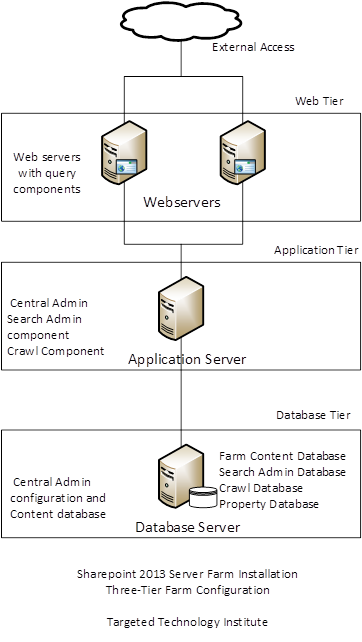Install SharePoint 2013 across multiple servers (three-tier farm)
[Adapted from Microsoft for instructional Purpose]
A three-tier farm configuration consists of two front-end web servers, an application server, and a database server. The deployment sequence and configurations that are described in this article are based on recommended best practices. While the farm configuration is not complex, it provides a fundamental infrastructure to implement a SharePoint 2013 solution.
In this short manual we will go through:
The basic steps in this deployment are as follows:
-
Ensure that you are familiar with the concept of a three-tier topology (Web -> Application -> Database Tiers)
-
Ensure that you have done all the planning and preparatory work, such as verifying hardware and software requirements (Preparation work determines the success of your Sharepoint installation and Configuration)
-
Install the required software updates on all servers that will be part of the farm (This is specially related to Windows Updates)
-
Install the SharePoint 2013 prerequisites on servers in the application and web tiers.
-
Install SharePoint 2013 on the application server and the web servers.
-
Create and configure the SharePoint farm.
-
Provision services.
-
Complete post-deployment tasks as required.
This topology is typically used for the medium and large farms described in Overview of SharePoint 2013 installation and configuration. In terms of performance, capacity, and scalability, a three-tier topology is recommended over a two-tier topology. A three-tier topology provides the most efficient physical and logical layout to support scaling out or scaling up, and it provides better distribution of services across the member servers of the farm. The following diagram shows the three-tier deployment that is described in this short manual.

Note the following in the above illustrative diagram:
-
You can add web servers to the web tier. These servers can be configured as conventional web servers to handle user requests, or they can be configured to host dedicated query components or other service components.
-
You can add farm servers to the application tier and configure them as dedicated servers that will host the SharePoint Central Administration website or other services on the farm that require dedicated resources or isolation from the web tier — for example, crawl components, query components, and profile pages.
-
You can add database servers to the database tier to implement a stand-alone instance, database mirroring, or a failover cluster. To configure the farm for high availability, database mirroring or a failover cluster is required on the database tier.
